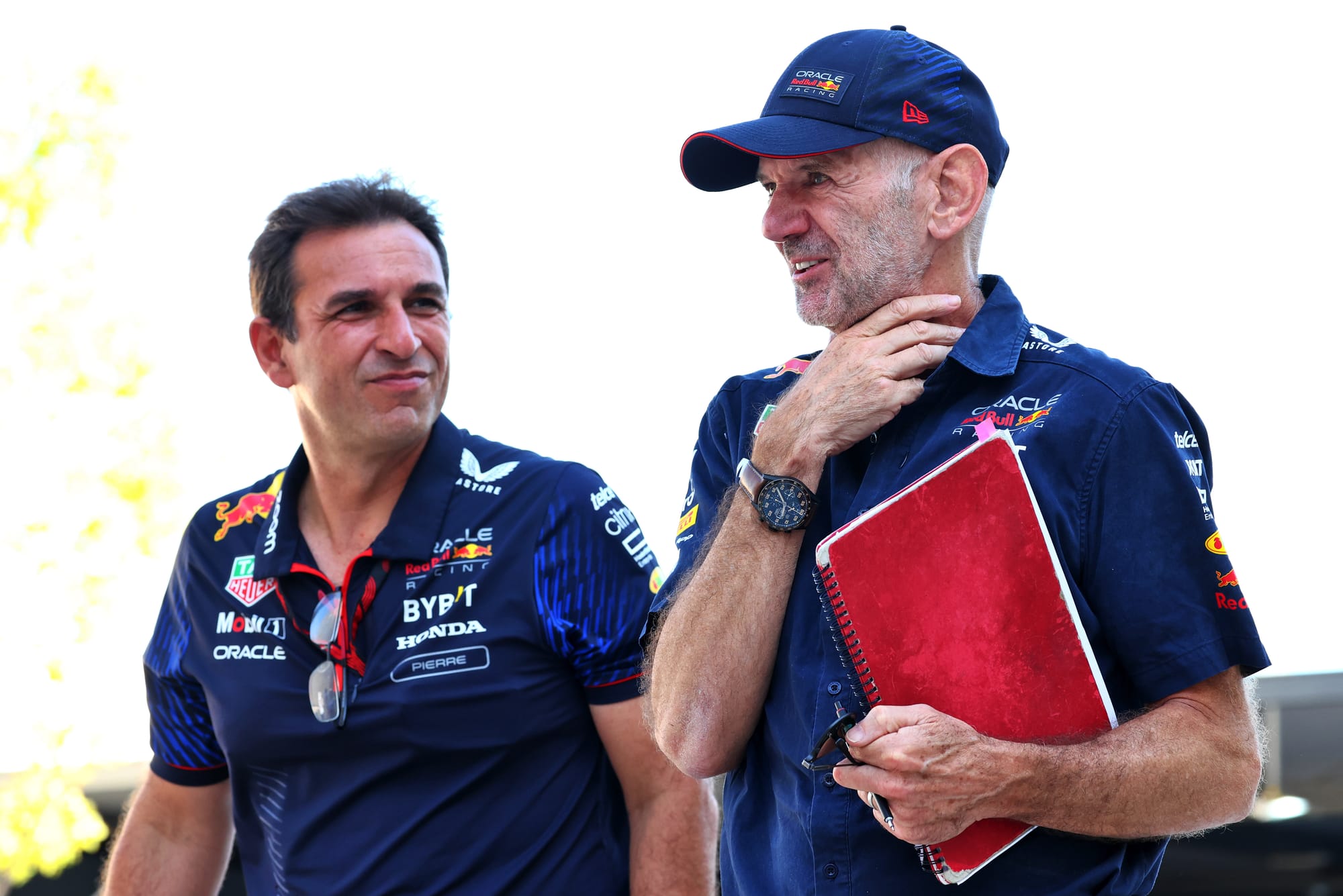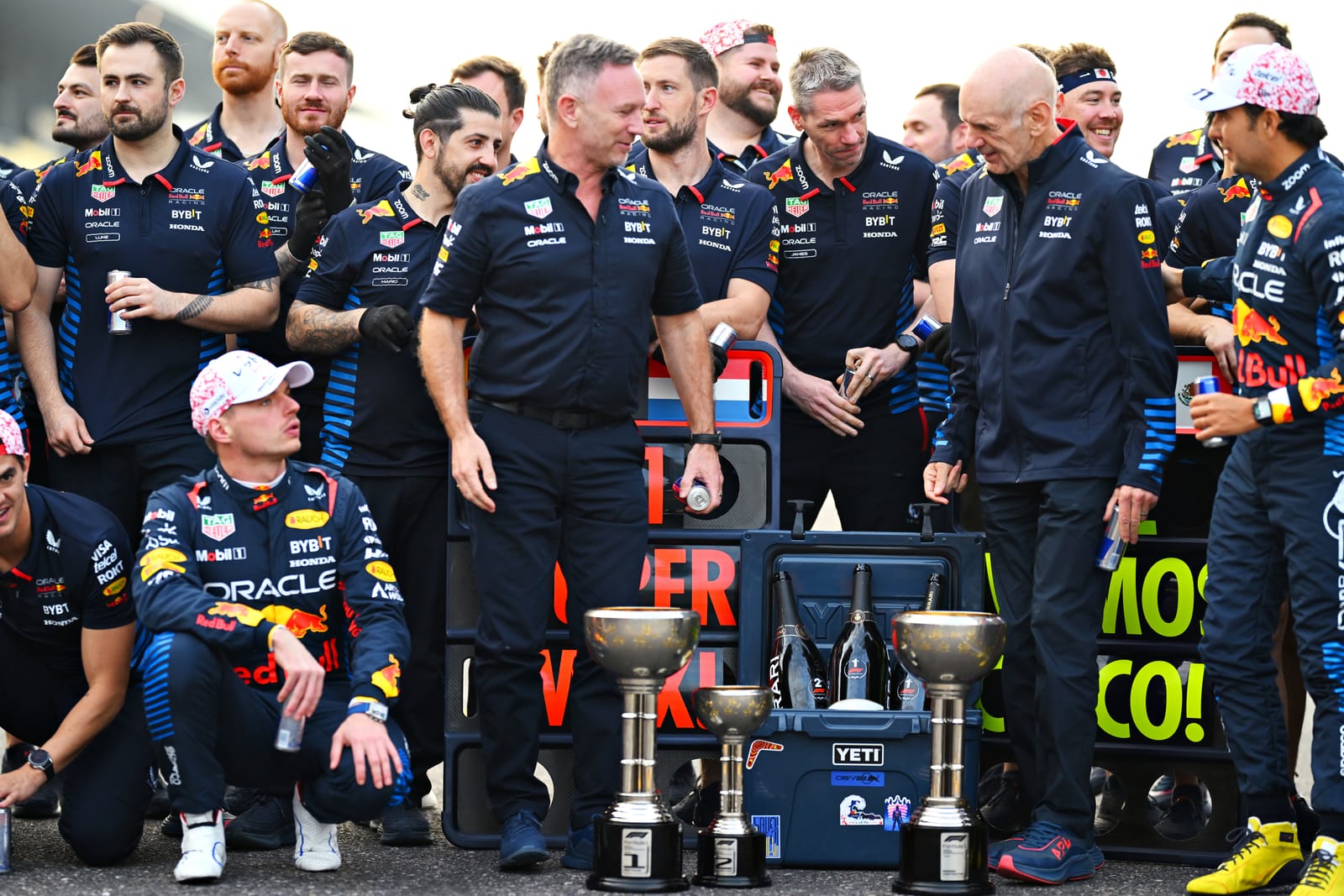

So who really created the last three blockbusting ground effect Red Bulls?
Has Adrian Newey simply been lending his name and the odd helpful suggestion while the real work was being done by the talented, but less famous, group of engineers within the Formula 1 team's technical group?
Christian Horner has for a couple of years now been very keen to publicly recognise the latter group, singling out aerodynamic chief Enrico Balbo for particular praise. Technical director Pierre Wache is also rightly proud of the RB18, 19 and 20, creations of his team of design and aerodynamic engineers.
But it’s not that simple. To properly grasp the reality, you need to know the unique structure of this technical group and Newey’s unique job description within it.
It’s commonly assumed that he is in charge of all things technical. He is not. Wache (pictured below with Newey) is the technical director and reports directly to Horner, not to Newey. Newey hasn’t fulfilled the role of technical director for almost a decade. He is free to contribute as much or as little as he chooses. That’s how Horner got him to stay when he was set to leave last time - that and the Aston Martin Valkyrie supercar project.

Newey feeds into the technical group, as does Balbo, as does chief designer Craig Skinner, head of performance engineering Ben Waterhouse and chief of car engineering Paul Monaghan. Wache co-ordinates the programmes of the various departments.
Newey is a concepts man, not simply an aerodynamicist. His intuitive big-picture understanding of what makes a car fast, of what the various sensitivities are and how they change through time and different regulations can be gold dust. Especially in a time of regulation change.
His deep understanding of car dynamics - and not just aerodynamics - has several times given the team a quick and effective fix to what might otherwise have been much longer-term problems. Unconstrained by either in-the-box thinking or even the contractual obligation to deliver, he’s a super-senior consultant, in effect. Even if his contract classes him as an employee.
He is not the guy to decide what he wants a car concept to be and getting everyone to follow his lead on that. That is not his personality or his job. He is not leading. He is supplying the gold dust. As and when it arrives. The others in the more traditional roles have the responsibility of ensuring the car is conceived and designed based on the best information they have.
When The Race interviewed Newey in early 2022, his answer to the question of how much he actually designed of the RB18 was as follows: “That’s a difficult one to answer. I’m lucky enough to have a really good group of people at Milton Keynes and it’s a very good team.
“All F1 teams are big engineering teams but in terms of the involvement in meetings, I put my tuppence-worth in but it’s the guys who bat those ideas around and maybe come up with a list and go away and do the work. Specifically, on this car [the RB18] I did the front and rear suspension and a few other bits and pieces.”

That sounds quite throwaway, doesn’t it? ‘Oh, the suspension and some other bits and pieces’. Yes, but behind that quite bland and understated summary was the gold dust which cracked the code of the all-new aero regulations of that year.
The RB18’s superiority was derived from a hugely sophisticated underfloor which deliberately sacrificed maximum downforce and a rear suspension with the travel and tricks within it to tame the porpoising phenomenon which tripped up everyone else.
That conceptual foundation was his and while the underfloor will have been created by the aerodynamicists under the supervision of Balbo, the performance markers used in the creation of that floor arose from Newey’s suggestion of what he believed would be the concept with the most promise. He did not insist on that concept, but the preliminary research conducted by the rest of the team following his suggestion found that it held more potential than the others.

Once that was established, off they all set on the adventure. That platform, and Newey’s suspension, has essentially remained the same through 2023 and 2024 and they have become arguably the most dominant family of cars in F1 history.
Newey didn’t design them. He didn’t even do the research. But he set the group of exceptional engineers off down a hugely productive path first time, without any of the flailing about seen almost everywhere else.
Would that engineering team have set off on that path were it not for Newey? Just as the chief scientist who wins the Nobel Prize takes the credit for a whole team of unknown scientists, many of whom may have provided the critical input which made the breakthrough. But were they only working in that direction because of the chief scientist’s original hunch?
So the question of ‘who should get the credit?’ is a simplistic one. It’s a deeply holistic process unsuited to simple black and white answers.

